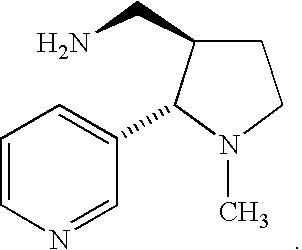Methods for decreasing the toxic effects of nicotine on fetuses in pregnant women
a technology for reducing the toxic effects of nicotine on fetuses and pregnant women, which is applied in the direction of antibody medical ingredients, peptide/protein ingredients, drug compositions, etc., can solve the problems of increasing the chance of problems during pregnancy, affecting the survival rate of fetuses, and increasing the incidence of spontaneous miscarriage and possibly ectopic pregnancy, so as to reduce the adverse effects of nicotine and reduce the birth weigh
- Summary
- Abstract
- Description
- Claims
- Application Information
AI Technical Summary
Benefits of technology
Problems solved by technology
Method used
Image
Examples
example 1
[0035]Seven groups of female, 6-8 month old, New Zealand White rabbits (195 total animals) were administered test or control articles three times by intramuscular injection on Days −30 and −9 Pre-Gestation and on Gestation Day 12 at a dose volume of 0.5 mL / kg (Table 1). The dosing schedule was designed to provide maximal anti-nicotine antibody levels during gestation. Groups 1 through 5 were comprised of 35 animals of which 25 does were subjected to Caesarean section and sacrifice on Gestation Day 29 for maternal and fetal evaluation and 10 does were allowed to deliver litters and assessed through Lactation Day 28. Groups 6 and 7 were comprised of 10 animals that were used for evaluation of nicotine levels in maternal and fetal blood at Gestation Days 20 and 29 (5 animals per group per day). A nicotine vaccine, NicVAX (AMNic-rEPA), was used for this study. NicVAX dose levels of 1.43 μg / kg and 35 μg / kg correspond to 1× and 25× the human dose on a weight / weight basis. The 35 μg / kg dos...
example 2
[0040]100 female New Zealand White rabbits were tested according to the study design detailed below (Table 2). The vehicle / adjuvant and test article were administered via intramuscular injection. Nicotine was administered by osmotic pump infusion. The pumps were surgically implanted subcutaneously. The dose volume of the test article and vehicle was 0.5 ml / kg. The dose rate of the pumps was approximately 5 μl / hr.
[0041]Study Design
[0042]
TABLE 2Dose levelGroup #(μg / kg)Test Article# FemalesMortality10Vehicle / Adjuvant (IM)20120Vehicle / Adjuvant (IM) / 203Nicotine (SC)31.43NicVAX (IM)200435NicVAX (IM)200535NicVAX (IM) / 201Nicotine (SC)
[0043]The test article and vehicle / adjuvant formulations were administered to the study animals once at 30 days prior to gestation, once at 9 days prior to gestation, and once on day 12 of gestation. Beginning at day 6 of gestation, does in Groups 2 and 5 received nicotine subcutaneously via osmotic pumps for two weeks.
[0044]Results indicated that gestation foo...
PUM
| Property | Measurement | Unit |
|---|---|---|
| molecular weight | aaaaa | aaaaa |
| birth weight | aaaaa | aaaaa |
| plasma | aaaaa | aaaaa |
Abstract
Description
Claims
Application Information
 Login to View More
Login to View More - R&D
- Intellectual Property
- Life Sciences
- Materials
- Tech Scout
- Unparalleled Data Quality
- Higher Quality Content
- 60% Fewer Hallucinations
Browse by: Latest US Patents, China's latest patents, Technical Efficacy Thesaurus, Application Domain, Technology Topic, Popular Technical Reports.
© 2025 PatSnap. All rights reserved.Legal|Privacy policy|Modern Slavery Act Transparency Statement|Sitemap|About US| Contact US: help@patsnap.com


